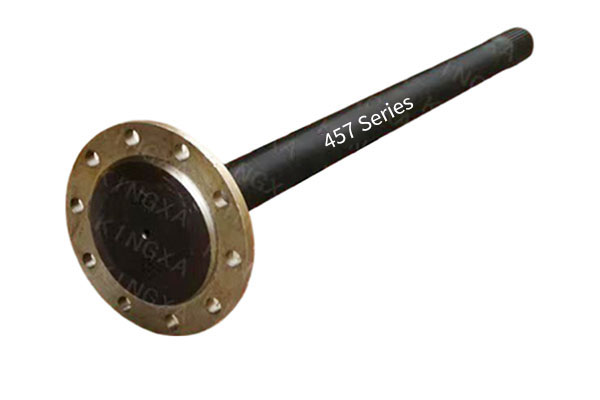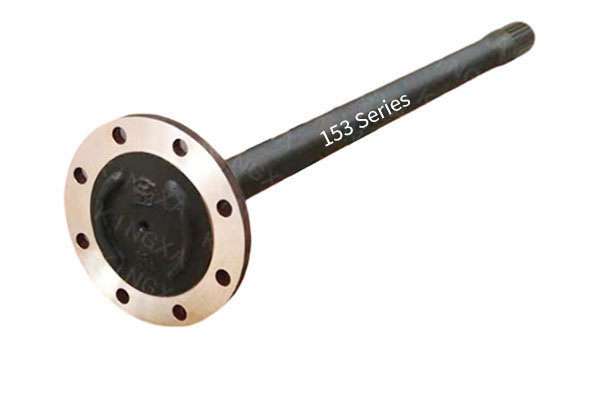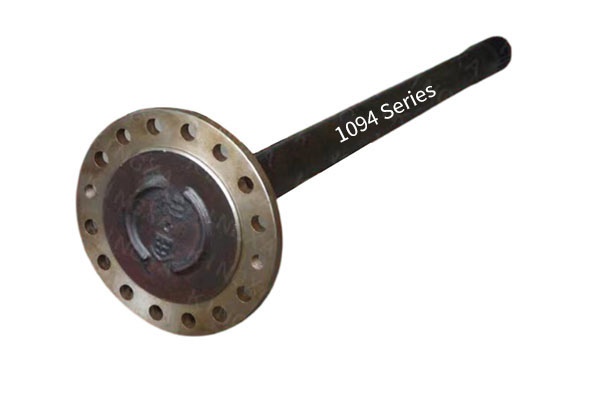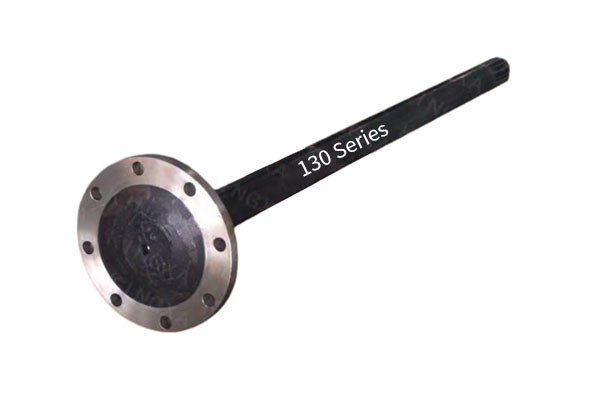How does mid-size car rear axle half shaft reduce energy loss?
Release Time : 2025-06-23
In modern automotive engineering, improving fuel efficiency and reducing emissions are two core goals. To achieve these goals, engineers not only focus on optimizing engine performance, but also strive to improve every component in the transmission system. Among them, mid-size car rear axle half shaft, as one of the key links in power transmission, has played an important role in reducing energy loss through a series of design and technological innovations.
1. Material selection: light weight and high strength
First of all, the choice of materials is crucial to reducing energy loss. Traditional mid-size car rear axle half shafts are mostly made of steel. Although they have good strength and durability, they are heavy and increase the energy consumption of vehicles when driving. In recent years, with the development of new material technology, aluminum alloys and other composite materials have gradually been used in the manufacture of half shafts. These materials can not only reduce weight, but also maintain sufficient strength and rigidity, thereby effectively reducing the energy required for vehicles during acceleration, deceleration and steering, and improving overall fuel economy.
In addition, some high-end models have begun to use carbon fiber reinforced plastics (CFRP) to manufacture mid-size car rear axle half shafts. This material not only has an extremely high strength-to-weight ratio, but also has excellent fatigue resistance, which can further reduce energy loss and improve the overall performance of the vehicle.
2. Precision manufacturing process: improving transmission efficiency
In addition to the material itself, the manufacturing process is also an important factor affecting energy loss. Advanced CNC machining technology and heat treatment processes make the surface finish of modern mid-size car rear axle half shaft higher and the dimensional accuracy more precise. This not only reduces friction loss, but also ensures smoothness and consistency during power transmission. For example, by optimizing the tooth design and surface hardening treatment, the friction coefficient between gears can be significantly reduced and the transmission efficiency can be improved.
In addition, the use of advanced forming processes such as cold forging or warm forging can further reduce the internal stress concentration phenomenon while ensuring product performance, extend the service life and reduce energy loss.
3. Intelligent lubrication system: reducing friction resistance
Friction is one of the main causes of energy loss. For this reason, many new mid-size car rear axle half shafts are equipped with intelligent lubrication systems to minimize friction resistance. These systems can automatically adjust the amount and pressure of lubricating oil according to working conditions to ensure that all moving parts are always in the best lubrication state. For example, the oil supply is increased when driving at high speed, and appropriately reduced when driving at low speed or idling, which not only ensures sufficient lubrication but also avoids unnecessary energy waste.
In addition, some high-end models also use nano-level lubricant additives, which can form an ultra-thin protective film on the metal surface, greatly reducing the chance of direct contact between metals, thereby effectively reducing wear and energy loss.
4. Aerodynamic optimization: reducing wind resistance
Although it is not directly related to "reducing energy loss", from the perspective of the whole vehicle, any design that helps to reduce energy consumption is valuable. Some mid-sized cars will take aerodynamic effects into special consideration when designing the rear axle area. By optimizing the chassis layout, such as reasonably arranging the exhaust pipe and the direction of the wire harness, the airflow can pass through the bottom of the car body more smoothly, reducing turbulence, and indirectly reducing the air resistance of the vehicle when driving, improving fuel economy.
5. Intelligent monitoring and maintenance reminders: preventive maintenance
Finally, with the help of Internet of Vehicles technology and big data analysis, modern mid-sized cars can monitor the working status of mid-size car rear axle half shaft in real time and provide maintenance suggestions based on actual conditions. In this way, car owners can promptly identify potential problems and take corresponding measures to prevent increased energy loss due to aging or damage of parts. For example, when abnormal vibration or temperature rise is detected in the half shaft, the system will immediately sound an alarm and prompt the user to check and repair as soon as possible to avoid greater losses.
In summary, from the perspective of mid-size car rear axle half shaft, by selecting high-performance materials, adopting precision manufacturing processes, introducing intelligent lubrication systems, and focusing on aerodynamic design, energy loss can be effectively reduced and the overall energy efficiency of the vehicle can be improved. This is of great significance for meeting increasingly stringent environmental regulations and improving user experience.
1. Material selection: light weight and high strength
First of all, the choice of materials is crucial to reducing energy loss. Traditional mid-size car rear axle half shafts are mostly made of steel. Although they have good strength and durability, they are heavy and increase the energy consumption of vehicles when driving. In recent years, with the development of new material technology, aluminum alloys and other composite materials have gradually been used in the manufacture of half shafts. These materials can not only reduce weight, but also maintain sufficient strength and rigidity, thereby effectively reducing the energy required for vehicles during acceleration, deceleration and steering, and improving overall fuel economy.
In addition, some high-end models have begun to use carbon fiber reinforced plastics (CFRP) to manufacture mid-size car rear axle half shafts. This material not only has an extremely high strength-to-weight ratio, but also has excellent fatigue resistance, which can further reduce energy loss and improve the overall performance of the vehicle.
2. Precision manufacturing process: improving transmission efficiency
In addition to the material itself, the manufacturing process is also an important factor affecting energy loss. Advanced CNC machining technology and heat treatment processes make the surface finish of modern mid-size car rear axle half shaft higher and the dimensional accuracy more precise. This not only reduces friction loss, but also ensures smoothness and consistency during power transmission. For example, by optimizing the tooth design and surface hardening treatment, the friction coefficient between gears can be significantly reduced and the transmission efficiency can be improved.
In addition, the use of advanced forming processes such as cold forging or warm forging can further reduce the internal stress concentration phenomenon while ensuring product performance, extend the service life and reduce energy loss.
3. Intelligent lubrication system: reducing friction resistance
Friction is one of the main causes of energy loss. For this reason, many new mid-size car rear axle half shafts are equipped with intelligent lubrication systems to minimize friction resistance. These systems can automatically adjust the amount and pressure of lubricating oil according to working conditions to ensure that all moving parts are always in the best lubrication state. For example, the oil supply is increased when driving at high speed, and appropriately reduced when driving at low speed or idling, which not only ensures sufficient lubrication but also avoids unnecessary energy waste.
In addition, some high-end models also use nano-level lubricant additives, which can form an ultra-thin protective film on the metal surface, greatly reducing the chance of direct contact between metals, thereby effectively reducing wear and energy loss.
4. Aerodynamic optimization: reducing wind resistance
Although it is not directly related to "reducing energy loss", from the perspective of the whole vehicle, any design that helps to reduce energy consumption is valuable. Some mid-sized cars will take aerodynamic effects into special consideration when designing the rear axle area. By optimizing the chassis layout, such as reasonably arranging the exhaust pipe and the direction of the wire harness, the airflow can pass through the bottom of the car body more smoothly, reducing turbulence, and indirectly reducing the air resistance of the vehicle when driving, improving fuel economy.
5. Intelligent monitoring and maintenance reminders: preventive maintenance
Finally, with the help of Internet of Vehicles technology and big data analysis, modern mid-sized cars can monitor the working status of mid-size car rear axle half shaft in real time and provide maintenance suggestions based on actual conditions. In this way, car owners can promptly identify potential problems and take corresponding measures to prevent increased energy loss due to aging or damage of parts. For example, when abnormal vibration or temperature rise is detected in the half shaft, the system will immediately sound an alarm and prompt the user to check and repair as soon as possible to avoid greater losses.
In summary, from the perspective of mid-size car rear axle half shaft, by selecting high-performance materials, adopting precision manufacturing processes, introducing intelligent lubrication systems, and focusing on aerodynamic design, energy loss can be effectively reduced and the overall energy efficiency of the vehicle can be improved. This is of great significance for meeting increasingly stringent environmental regulations and improving user experience.







